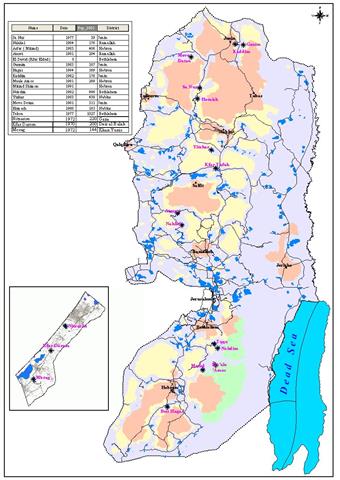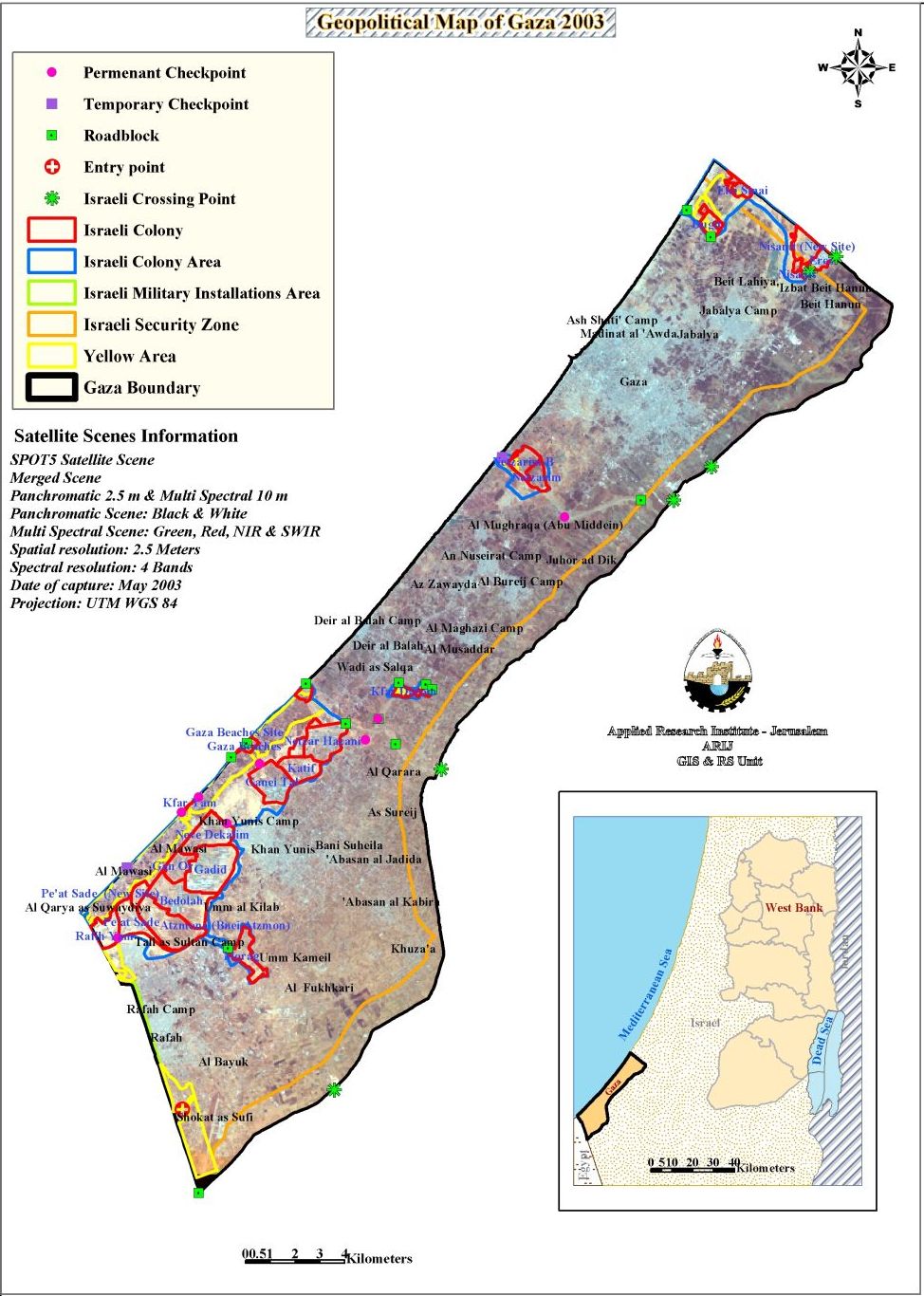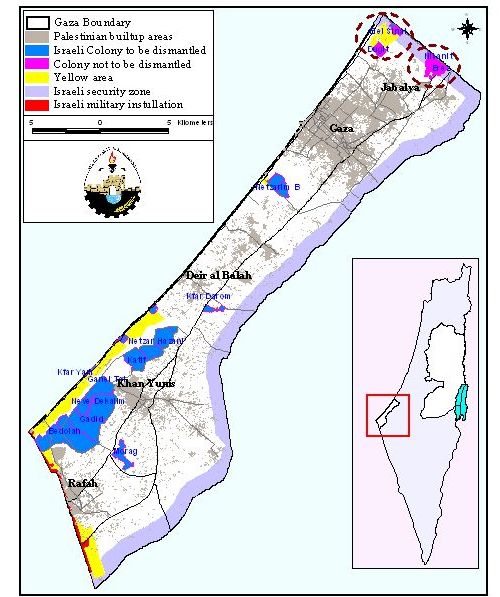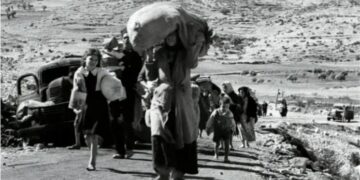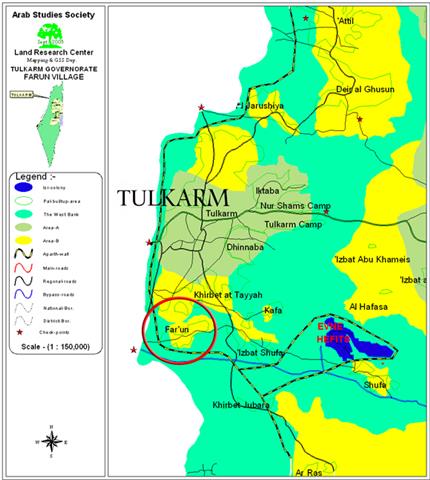The Gaza Strip has an area of 365 Km2 and a total Palestinian population of 1.4 million Palestinians of which around 900 thousand (64% of the population) are refugees, a place where the population density reaches over 7000 persons/1Km2 , (the highest all over the World).
Since the occupation of the Palestinian Territories by Israel in 1967 and until today, the Israeli governments were able to construct 21Israeli settlements, in addition to an Israeli industrial zone, security zone, military installation areas, and areas classified as a yellow zone (areas under Israeli control). Today, Israel still controls 165 Km2 (45%) of the Gaza Strip, while the remaining 200 Km2 (55% of Gaza Strip) became under Palestinian control in 1994.
The 1.4 million Palestinians living in the Gaza Strip today are restricted by 24 checkpoints and roadblocks established by the Israeli army all through Gaza. Only one checkpoint is opened (with restrictions) to the Palestinians to move across from one district to another or even within the same district, otherwise the Palestinians had to resort to backside roads system to get around. The checkpoints that are normally located in close proximity of the Israeli settlements constitute a security site to guard the settlers' passageway in Gaza.
Recently, Israel's Prime Minister Ariel Sharon has declared that he will take unilateral steps to withdraw from 17 Israeli settlements (out of 21) located in the Gaza Strip, accommodating 7,500 Israeli settlers (population density 43/1Km2) ''See Table 1''. Two Israeli sites anticipated for evacuation are in fact ''outposts'' (Kerem Atzmona & Shiraat Ha Yam) but proclaimed as settlements by the Israelis.
PM proclaimed that the decision was made for the long-term interest of Israel, while the four remaining settlements are to stay under Israeli jurisdiction. The {Strategic} withdrawal plan comes in parallel with Sharon's most recent announcement that ''the Palestinians would get less under a unilateral withdrawal than they would have under a negotiated peace deal''. In his announcement, PM Sharon did not name the 17 settlements designated for withdrawal and did not set a time frame for the withdrawal process. The single most significant precedent of such magnitude made in Israel is no other than the Sinai and Taba settlements withdrawal and dismantling under the late PM of Israel in 1982 Menahim Baigin, who made the decision and delegated no other than the current PM Ariel Sharon to carry out the task.
|
Table 1: Israeli Settlements Population in Gaza (2002) |
||
|
# |
Settlement |
Population |
|
1 |
2,501 |
|
|
2 |
943 |
|
|
3 |
Bnei Atzmon (Atzmona) |
567 |
|
4 |
410 |
|
|
5 |
382 |
|
|
6 |
377 |
|
|
7 |
360 |
|
|
8 |
346 |
|
|
9 |
338 |
|
|
10 |
Gadid |
324 |
|
11 |
321 |
|
|
12 |
217 |
|
|
13 |
170 |
|
|
14 |
149 |
|
|
15 |
95 |
|
|
16 |
76 |
|
|
17 |
Kerem Atzmona (outpost) |
NA |
|
18 |
NA |
|
|
19 |
Shiraat Ha Yam (outpost) |
NA |
|
20 |
Tel Katifa |
NA |
|
Total |
7,576 |
|
|
Predicted Israeli settlements to remain under Israeli control |
||
What is the Catch?
At the time, that this unilateral decision to withdraw from 17 settlements located in the Gaza Strip seems exceptionally dazzling, one must question the true intentions that fall behind such widely debatable decision. The PM evacuation plan was not the first, but his latest version after experimenting with earlier pullout plan put forward in December 2003, which designated 14 settlement in the West Bank and 3 settlements in Gaza and the settlers council refused to consider, See Map 1. .
Further Israeli sources anticipate that the Israeli settlers to be evacuated from Gaza will in all probability be relocated in Israeli settlements in the West Bank (Ariel, Gush Etzion & Ma'aleh Adumim) and not into Israel behind the Green line, in which case, the Israelis will fortify the settlers' existence over Palestinian soil. Even-thought, no details of any nature were released concerning the 17 settlements subject of withdrawal, it is anticipated that the Israelis will not abandon the three settlements located north of Gaza along the northern border (Elei Sinai, Nisanit & Dugit accommodating 1380 Israeli settler) and Erez Industrial Zone; all located in Jabalya District and spread over 7 Km2 (1.9%) of Gaza Strip. The targeted 17 settlements are located in Gaza district, Deir Al-Balah district, Khan Yunis district & Rafah district occupying 24.5 Km2 (6.5%) of Gaza Strip ''See Table 2 & Map 2 below''., & accommodating 1380 Israeli settler) and Erez Industrial Zone; all located in Jabalya District and spread over 7 Km (1.9%) of Gaza Strip. The targeted 17 settlements are located in Gaza district, Deir Al-Balah district, Khan Yunis district & Rafah district occupying 24.5 Km (6.5%) of Gaza Strip ''.
|
Table 2: Areas controlled by Israel in Gaza Strip |
|
|
Jewish settlement area |
53.7 Km2 |
|
Israeli settlement |
26.66 Km2 |
|
Israeli security zone |
58.03 Km2 |
|
Israeli Military Installation Areas |
2.418 Km2 |
|
Yellow Areas |
15.8 Km2 |
|
Buffer Zones (Shaved) |
8.43 Km2 |
|
Total |
165.038 |
In 1996, the 55 Km2 (15% of Gaza Strip) Security Belt in conjunction with Gaza Strip eastern border was completed and the decision taken by Israel's PM in 2004 to withdraw from the anticipated 17 Israeli settlements come in parallel as it excluded the anticipated settlements for evacuation.
Apparently, the Israeli side will maintain control on Gaza gateway (northern border) to the West Bank in addition to the security belt which rope in Gaza eastern border, See Map 3..
The Separation Plans
PART I: Gaza
The Head of the Israeli National Security Council Gior Eyland is about to present three different disengagements plans to the Israeli PM Ariel Sharon before the later anticipated visit to the US. The suggested disengagement plans are to be deliberated by the Israeli government to nominate one plan to go with for Gaza. The plans are:
Plan I:
The suggested is summarized in the preceding analysis of the pullout plan from Gaza.
Plan II:
Plan II is the disengagement plan suggested by Israel Defense Minister Sha'oul Mofaz, which calls for evacuation of all Israeli settlers from the Gaza Strip and replace them with Army troops in addition to keeping the Israeli settlements located in Jabalya district north of Gaza, including Erez Industrial Zone under Israeli control. The idea was harshly rejected as it contradict the essence of the disengagement plan and maintain friction elements with the Palestinian population which the Israelis are attempting to evade through the withdrawal plan in the first place.
Plan III:
The third choice of the suggested plans calls for evacuation of three Israeli settlements ''Morag, Netzarim & Kfar Darom''.
The disengagement plans suggested are nothing but a mere flares attempting to show that Israel is not caving to Palestinian pressure and considers several options to withdraw ''voluntarily'' from the Gaza Strip. Nevertheless, Israel might still adopt all three plans before it completes its withdrawal from Gaza starting from Plan III, then Plan II to Plan I in which it will reach an accord with the Palestinian Authority. On January 19, February 6, and February 22, 2004 notifications were issued by Israeli Army to of dozens Palestinian families notifying them that the Israeli Army intends to confiscate hundred of Dunums for military purposes. The areas targeted for confiscation are within the vicinity of three Israeli settlements that are supposed to be evacuated from Gaza according to the evacuation plan, those settlements are: Netzarim, Kfar Darom & Morag, and all are isolated from other Israeli settlements blocks. The confiscation notifications for the area near Netzarim settlement include 27 Dunums (11 acres), the area that Israel intends to rope-in the settlement with a ''Security Wall''. While the threatened area includes 27 Dunums; the confiscation will actually result in isolating hundreds of Dunums of agricultural lands located between the so called ''security wall'' and Netzarim and belong to Palestinian farmers. The confiscation order for the Israeli settlement Kfar Darom (in Dier Al-Balah district) was more straightforward as it declared 900 Dunums (360 acres) of Palestinian lands confiscated for security purposes. The confiscation order issued over two times period (January 2004 & February 2004) and aims to create a security Zone around the Israeli settlement vicinity. The Israeli settlement Morag is also set to be delimited with a Security Wall distant some 400 meters (440 yards) and consequently will deny Palestinians access to hundreds of Dunums of agricultural lands that fall between the Security Wall and the actual settlement.
The confiscation orders contradict with the suggested disengagement ''Plan III'' submitted by the Head of the Israeli National Security Council, which calls to evacuate Netzarim, Kfar Darom & Morag. Israel has always adopted perplex approach to its actions to rule out any notion of pressure and demonstrate freedom of choice on its part.
PART II: The West Bank
The Israeli National Security Council devised four disengagement plans from the West Bank for the Israeli government to debate and deliberate.
Plan I:
The plan evolves to a concept, which considers the withdrawal plan from Gaza the only climax act made on the Israeli part with regard to the Israeli settlements issue including the 210 settlements scattered allover the West Bank.
Plan II:
The second plan is an ''intuition'' presumed by the Israeli National Security Council and calls for dismantling only few settlements north of the West Bank (i.e. Shanour, Kadim & Ghaniem). It is the Israelis' perception that such limited evacuation of Israeli settlements makes the Palestinians feel that Israel has concluded its part of the deal by dismantling Gaza settlements and that no territorial accord regarding the West Bank settlements is likely to take place.
Plan III:
Plan number three calls for territorial contiguity for the Palestinian built-up areas by dismantling settlements along Wadi Houara (i.e. Taphoh, Yitzhar, and Bracha). The plan also calls for dismantling isolated Israeli settlements spread around the West Bank.
Plan IV:
The plan calls for dismantling the majority of the Israeli settlements in the West Bank while maintaining three bulky settlements blocs.
Israel is attempting to escape the interim agreement signed with the Palestinian Authority which bestow the Palestinian Authority control over 95% of the West Bank and Gaza (excluding issues of the final permanent status negotiations: Jerusalem , settlements, borders and refugees). Furthermore, the plans do not correlate with the US Roadmap Plan that calls for the creation of a viable Palestinian State with territorial contiguity by the end of 2005. The plans are an Israeli attempt to set its guidelines for the long dragged final negotiation with the Palestinians.
Contrary to the Segregation Wall in the West Bank, which embraces various settlements blocks; both the Security Belt in Gaza and the segregation Wall in the West Bank were constructed and formed to establish political borders for the State of Israel contrary to Israeli officials claims which tribute the detachment process in Gaza and the West Bank to ''security'' professes.
Israel will maintain control over 63 Km2 (17%) of Gaza Strip for allegedly security purposes (55 Km2 Security belt, 1Km2 Buffer Zone separating Israeli settlements area north of Gaza from Palestinian built-up areas and 7 Km2 Israeli settlements area under Israeli jurisdiction). It is likely that Israel will also hold on to 14 Km (14 Km2 – 3.8% of Gaza) security zone (belt) that stretches along Gaza southern border with the Egyptian border in that area. Within the stretch, there are 2.4 Km2 of Israeli military installations and 4.4 Km2 of yellow areas. The remaining area which embrace quarters of Rafah and Rafah Refugee Camp were subject to vindictive and systematic Israeli attack that included bombardment of residential areas which resulted in the demolition of 300+ houses and destitution of thousands of Palestinians in that area.
It seems that Israel have sought to take a unilateral step to maximize its control of Gaza Strip, and control its only pathway to the West Bank, meaning that Sharon wants to leave the Gaza Strip; close it and keep the key. By doing so, Sharon will consciously detach Gaza from the West Bank creating in process two different entities unloading in one of them (Gaza) 1.4 million Palestinians that he and the successive governments of Israel would not have to worry about and dexterously Judaize the West Bank including Jerusalem, the separation process will also eliminate any possibility for creating a viable Palestinian state.
Sharon intention to evacuate or dismantle any Israeli settlement remain questionable, otherwise he already would have dismantled the 117 illegal outposts rigged in the West Bank and mainly located in close proximity to identified settlements.
Don't Hold Breath
Is Israel PM Sharon expecting applause for his intention to withdraw and evacuate settlements from Gaza? Will; he should not hold his breath, for this should have been done decades ago, even more it should not have happened in the first place. Furthermore, Israel should have already bygone from Gaza and almost entirely from the West Bank if it had bonded by the peace accords signed with the Palestinians. The Israeli settlements had always been an indisputable violation of the international Law under the UN Security Council Resolutions 242, 446, 452 & 465 and the Forth Geneva Convention Accord of 1949; Articles 47 &49 and any withdrawal must correlate to this end and not as a good will gesture to the peace process on the Israeli side.
Prepared by:
The Applied Research Institute – Jerusalem


